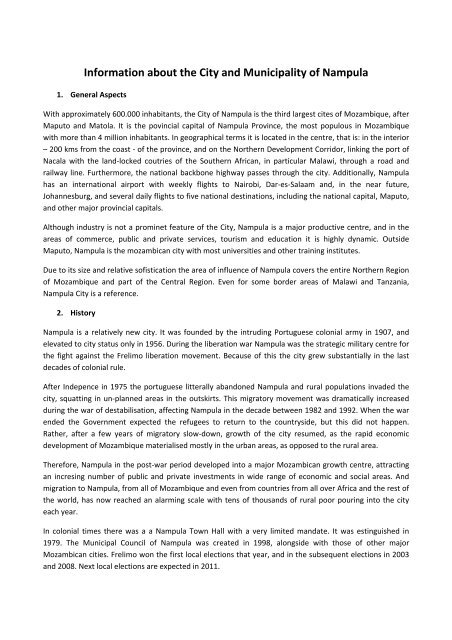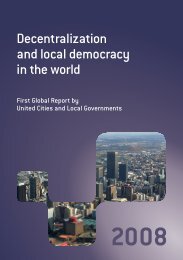City Profile - Nampula - UCLG
City Profile - Nampula - UCLG
City Profile - Nampula - UCLG
Create successful ePaper yourself
Turn your PDF publications into a flip-book with our unique Google optimized e-Paper software.
Information about the <strong>City</strong> and Municipality of <strong>Nampula</strong><br />
1. General Aspects<br />
With approximately 600.000 inhabitants, the <strong>City</strong> of <strong>Nampula</strong> is the third largest cites of Mozambique, after<br />
Maputo and Matola. It is the povincial capital of <strong>Nampula</strong> Province, the most populous in Mozambique<br />
with more than 4 million inhabitants. In geographical terms it is located in the centre, that is: in the interior<br />
– 200 kms from the coast ‐ of the province, and on the Northern Development Corridor, linking the port of<br />
Nacala with the land‐locked coutries of the Southern African, in particular Malawi, through a road and<br />
railway line. Furthermore, the national backbone highway passes through the city. Additionally, <strong>Nampula</strong><br />
has an international airport with weekly flights to Nairobi, Dar‐es‐Salaam and, in the near future,<br />
Johannesburg, and several daily flights to five national destinations, including the national capital, Maputo,<br />
and other major provincial capitals.<br />
Although industry is not a prominet feature of the <strong>City</strong>, <strong>Nampula</strong> is a major productive centre, and in the<br />
areas of commerce, public and private services, tourism and education it is highly dynamic. Outside<br />
Maputo, <strong>Nampula</strong> is the mozambican city with most universities and other training institutes.<br />
Due to its size and relative sofistication the area of influence of <strong>Nampula</strong> covers the entire Northern Region<br />
of Mozambique and part of the Central Region. Even for some border areas of Malawi and Tanzania,<br />
<strong>Nampula</strong> <strong>City</strong> is a reference.<br />
2. History<br />
<strong>Nampula</strong> is a relatively new city. It was founded by the intruding Portuguese colonial army in 1907, and<br />
elevated to city status only in 1956. During the liberation war <strong>Nampula</strong> was the strategic military centre for<br />
the fight against the Frelimo liberation movement. Because of this the city grew substantially in the last<br />
decades of colonial rule.<br />
After Indepence in 1975 the portuguese litterally abandoned <strong>Nampula</strong> and rural populations invaded the<br />
city, squatting in un‐planned areas in the outskirts. This migratory movement was dramatically increased<br />
during the war of destabilisation, affecting <strong>Nampula</strong> in the decade between 1982 and 1992. When the war<br />
ended the Government expected the refugees to return to the countryside, but this did not happen.<br />
Rather, after a few years of migratory slow‐down, growth of the city resumed, as the rapid economic<br />
development of Mozambique materialised mostly in the urban areas, as opposed to the rural area.<br />
Therefore, <strong>Nampula</strong> in the post‐war period developed into a major Mozambican growth centre, attracting<br />
an incresing number of public and private investments in wide range of economic and social areas. And<br />
migration to <strong>Nampula</strong>, from all of Mozambique and even from countries from all over Africa and the rest of<br />
the world, has now reached an alarming scale with tens of thousands of rural poor pouring into the city<br />
each year.<br />
In colonial times there was a a <strong>Nampula</strong> Town Hall with a very limited mandate. It was estinguished in<br />
1979. The Municipal Council of <strong>Nampula</strong> was created in 1998, alongside with those of other major<br />
Mozambican cities. Frelimo won the first local elections that year, and in the subsequent elections in 2003<br />
and 2008. Next local elections are expected in 2011.
3. Area, Administrative Division and Population<br />
The jurisdication of <strong>Nampula</strong> Municipality covers an area of 404m2, divided into 6 Municipal Administrative<br />
Posts, which again are divided into a total of 18 neighbourhoods, of which 6 in the Central Business District<br />
and 12 in the peri‐urban areras.<br />
In the last population census carried out in 1997 <strong>Nampula</strong> had close to 480.000, but due to the accelerated<br />
yearly population growth rate of 5,7%, is now more likely to be 600.000. It is expected that this number will<br />
increase to 1.000.000 before 2010. Half of the population are less than 15 years old.<br />
Of this only 4% live in the CBD, while 96% live in the peri‐urban neighbourhoods. It is estimated that 80% of<br />
the population live in unplanned areas, most of which with high population densities and appalling<br />
environmental and living conditions.<br />
4. Socio‐Economic Indicators<br />
It is estimated (2005), that almost half of the adult population is unemployed and that only 40% had an<br />
income above the minimum salary of 100 usd per month. According to the latest statistics, urban poverty<br />
and inequality is increasing. The amount of beggars and street children is at the raise.<br />
80% of residential houses are sub‐standard huts built of local materials such as sticks, poles and mud and<br />
with roofs of grass or corrugated iron sheets. Only 36% of households have som kind of sanitation.<br />
The coverage of piped watersupply is around 43%, while only 14% of households have electricity.<br />
5. Problems, Challenges and Actions Taken<br />
The main problem faced by <strong>Nampula</strong> is the massive migration of poor people to the city, which has resulted<br />
in the loss of control of land management and turned urban planning extremely difficult. In 2009 <strong>Nampula</strong><br />
therefor embarked on a city‐wide slum upgrading strategy to addess this issue through the preparation of<br />
comprehensive urban plans for each of the 12 peri‐urban neighbourhoods. In paralel a programme for land<br />
tenure regularisation will be kicked of in March 2011, in order to secure land rights, especially of the poor<br />
and other vulnerable groups.<br />
The additional challenge is, however to mobilise sufficient resources to implement the urban plans.<br />
Fortunately, water and energy supply systems will be significantly increased in the coming years, and the<br />
storm water drainage system will be rehabilitated and expanded. However, funds are still very scarce, in<br />
particular for the improvement of access to the residential areas and of housing conditions themselves.<br />
The solid waste management is another area of concern, since the city has no land‐fill and insufficient<br />
equipment and staff to ensure a regular collection. However, a strategy has been prepared and a Solid<br />
Waste Management Master Plan will be concluded in 2011. Resources for implementation are being<br />
negotiated with potential partners.<br />
Finally there is the problem of poverty per se. The Mozambican Government and the individual<br />
municipalities are preparing strategies to address the issue, and funds have been made available to more<br />
efficiently deal with urban poverty. Specific strategies and actions are being developed for street‐children.
















